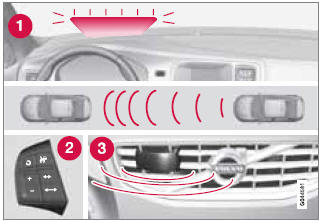 Volvo S60: Function
Volvo S60: Function

Function overview
1 - Warning light, braking by driver required
2 - Controls in steering wheel
3 - Radar sensor in front grille
Adaptive Cruise Control consists of:
- A cruise control system to maintain a set speed
- A system to maintain a set distance to the vehicle ahead, which is expressed as a time interval. For example, you can choose to remain approximately 2 seconds behind the vehicle ahead. The actual distance required to maintain a 2-second interval will vary according the speed of the vehicles.
![]() WARNING
WARNING
- Adaptive Cruise Control is not a collision avoidance system. The driver is always responsible for applying the brakes if the system does not detect another vehicle.
- Adaptive Cruise Control does not react to people or animals, or small vehicles such as bicycles and motorcycles. It also does not react to slow moving, parked or approaching vehicles, or stationary objects.
- Do not use Adaptive Cruise Control in demanding driving conditions such as city driving or other heavy traffic situations, in slippery conditions, when there is a great deal of water or slush on the road, during heavy rain or snow, in poor visibility, on winding roads or on highway on- or off-ramps.
The distance to the vehicle ahead (in the same lane) is monitored by a radar sensor. Your vehicle's speed is regulated by accelerating and braking. The brakes may emit a sound when they are being modulated by the adaptive cruise control system. This is normal.
![]() WARNING
WARNING
The brake pedal moves when the adaptive cruise control system modulates the brakes. Do not rest your foot under the brake pedal.
The ACC system is designed to smoothly regulate speed. However, the driver must apply the brakes in situations that require immediate braking. This applies when there are great differences in speed between vehicles, or if the vehicle ahead brakes suddenly.
![]() WARNING
WARNING
Due to limitations in the radar sensor, braking may occur unexpectedly or not at all, see page 160.
Adaptive Cruise Control can be put in active mode at any permitted speed. However, if the vehicle's speed falls below 18 mph (30 km/h) or if engine speed (rpm) becomes too low, ACC disengages (goes into standby mode) and will no longer modulate the brakes2. The driver will then have to maintain a safe distance to the vehicle ahead.
![]() WARNING
WARNING
When Adaptive Cruise Control is in standby mode or is switched off completely, the brakes will not be modulated automatically. The driver must assume full control over the vehicle.
 Introduction
Introduction
Adaptive Cruise Control (ACC) is an optional system designed to assist the driver
by maintaining a set speed or a set time interval to the vehicle ahead. It is primarily
intended for use on long s ...
 Warning light—driver braking required
Warning light—driver braking required
Adaptive Cruise Control can exert brake force that is equivalent to approximately
40% of the vehicle's total braking capacity. In situations requiring more brake
force than ACC can provide and ...
See also:
Vehicle equipment
All standard, country-specific and optional
equipment that is offered in the model series is
described in this chapter. Therefore, equipment
is also described that is not available in a vehicle, ...
General information
The navigation system can determine the precise
position of the vehicle, with the aid of satellites
and vehicle sensors, and can reliably
guide you to every entered destination.
Navigation data ...
Courtesy Lights
Your vehicle has a courtesy light in
the ignition switch. This light comes
on when you open the driver’s door.
It fades out in about 30 seconds after
the door is closed. ...
